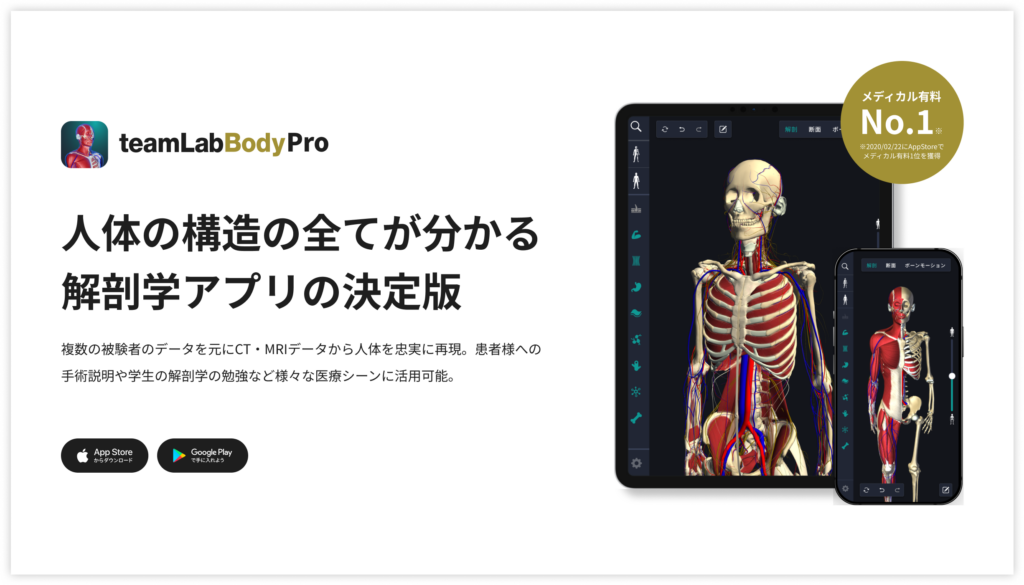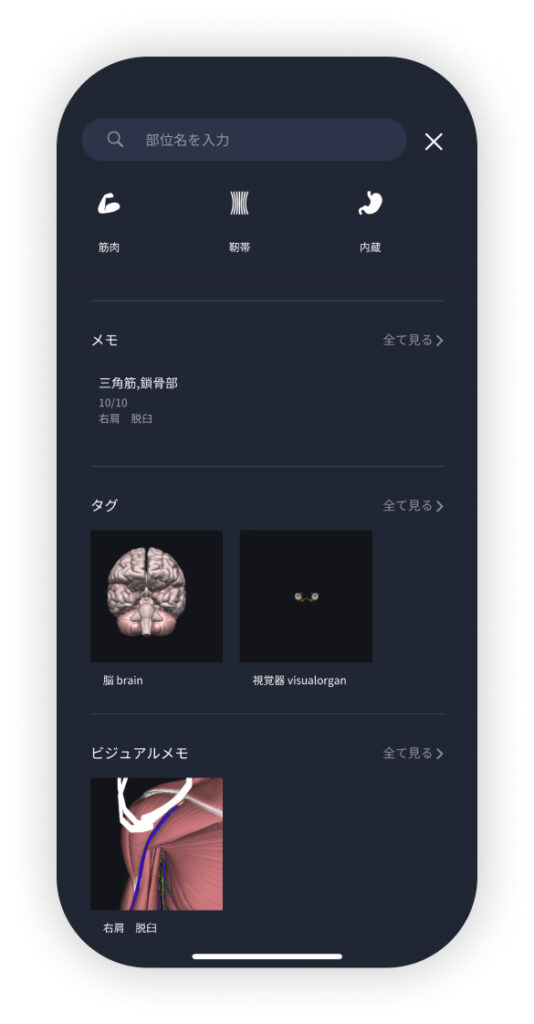beginning
In this article, I will explain effective study methods, starting with knowledge of specialized parts in human anatomy.
In human anatomy, it is necessary not only to memorize the names of various organs, muscles, and bones, but also to remember where they are located in the body. Therefore, it is necessary to learn as efficiently as possible.
I hope you will deepen your understanding even a little by reading this article and using the app.
Now, I will explain the details about the “lateral thyrohyoid ligament” and how to study human anatomy.
teamLab Body Pro Free Download
A 3D anatomy app that shows all the structures of the human body
Download teamLab Body Pro here!

What is the lateral thyrohyoid ligament?
The anatomy application allows you to view a selection of anatomy 3D models. In this model, there are various observation methods such as surfaces, cross-sections, and nervous systems. This time, I'll explain using an anatomy application.
About lateral thyrohyoid ligament

The lateral thyrohyoid ligament (lateral thyrohyoid ligament)superior horn of thyroid cartilage and large horn of hyoid boneIt is a ligament that connects, and is classified as part of the thyrohyoid membrane (thyrohyoid membrane). These ligaments exist in pairs on the left and right, and are one of the structures that support the stability of the pharynx and larynx.
Also, within the ligamentsexternal branch of superior laryngeal nerve and superior laryngeal arteryIt may form a foramen (foramen) through which it passes, and it is a clinically important landmark. As part of the structure involved in movements such as vocalization and swallowing, it provides a foundation for muscles, nerves, and blood vessels to work in concert while supporting the larynx.
In particular, the lateral thyrohyoid ligamentsuperior laryngeal nerve palsyThere is a possibility of damage due to laryngeal surgery, etc., so understanding its location and surrounding structures is essential in terms of both anatomy and clinical practice.
Study points
Anatomical understanding: accurately capture structure and positional relationships
First, let's grasp the positional relationship of thyroid cartilage, hyoid bone, and thyrohyoid periosteum three-dimensionally. The lateral thyrohyoid ligament is located between the superior horn of the thyroid cartilage and the large horn of the hyoid bone, and is equivalent to the outer part of the thyrohyoid periosteum.3D anatomy apps and larynx modelsIf you use it to learn positional relationships with other ligaments and muscles in the larynx (cricothyroid muscle, cleft thyroid muscle, etc.) together, it will lead to an understanding of function.
Functional understanding: learning in relation to movement
This ligament is a fulcrum for the hyoid bone and thyroid cartilage to move in coordination during vocalization and swallowing while increasing larynx stability. Feeling the movement of the tongue bone and larynx by actually drinking water or making a voice is useful for functional understanding. In particular, during swallowing, the hyoid bone moves upward and forward, and the larynx also moves along with it, but let's imagine how the tension of the lateral thyrohyoid ligament adjusts in response to this movement.
Practical application: deepening from clinical relationships
The lateral thyrohyoid ligament issuperior laryngeal nerve (especially external branches) and superior laryngeal arteryIt is related to the area where it passes, and is important as a risk site during nerve damage or surgery. When symptoms such as difficulty making a voice or adjusting pitch occur, anatomical understanding of this area may be the key to diagnosis and treatment. In particular, in otolaryngology procedures, it is necessary to accurately grasp the positional relationship between nerve movement and ligaments.
How to study human anatomy
I will explain specific study methods using human anatomy applications.
Check your past learning history and practice repeatedly
Here are the steps to check your anatomy learning history and practice iteratively effectively.
1. Check your learning history in the app
Reviewing your learning history with the application is an important step in effectively advancing anatomy learning. First, launch the app and go to the learning history section from the main menu. Many anatomy apps are designed to show your progress in the form of graphs and lists, so you can visually check which parts you've learned about and how much time you've spent.
By using this data, you can understand which areas you have strengths in and where you need to spend more time and effort. We also recommend using a dedicated tag or notebook function to mark areas you are particularly weak at or where you need to relearn. Regularly checking your learning history and looking back on past learning content will lead to efficient review and deepening understanding.
2.Make a plan for iterative learning
Making an efficient repetitive learning plan based on learning history is extremely effective in promoting knowledge retention. First, identify weak points and areas where you need to relearn. Next, arrange these study items into a weekly or monthly calendar and create a specific study schedule. By proceeding in a planned manner, you can learn each part evenly and avoid packing in a large amount of information at once.
Using a task management app or digital calendar to set study reminders is effective. Also, it's important to have the flexibility to regularly review progress and revise plans as needed. By having goals and proceeding with your studies in a planned manner, you can efficiently acquire anatomical knowledge.
3.Use 3D features to learn visually
By utilizing the 3D function, learning anatomy is easier to understand visually. The 3D model shows the structure of the human body three-dimensionally, and each part can be observed in detail. This makes it possible to intuitively grasp positional relationships between deep muscles and organs that are difficult to capture in a planar view. For example, you can learn even the smallest details by rotating specific muscles and bones and zooming in and out.
Also, there are many apps that have the function of displaying cross-sectional views of each part using a 3D model, which is useful for deepening understanding of internal structures. This diversity of visual information helps with memory retention and improves immediate responsiveness in tests and practice situations. By utilizing the 3D function and learning visually, you can learn anatomy knowledge more deeply and efficiently.
Use the memo function concretely

Make notes so you don't forget the things and points you've noticed while studying. The memo function can be used for different purposes, such as inputting text, saving images, and writing memos. Tag your notes to make them easier to review later.
Test your learning regularly in the form of quizzes
Regularly testing what you've learned in a quiz format is a very effective way to anchor your anatomy knowledge. Quiz-style tests help you objectively grasp your level of understanding and areas you lack while repeating knowledge.
For example, by using a learning app to conduct quizzes every specific period, you can reconfirm what you've learned and strengthen your memory. There are a wide range of quiz formats, such as multiple choice questions, fill-in-the-blank questions, and short answer questions, and each helps understanding from a different angle and develops the ability to utilize various types of knowledge.
Get feedback
If possible, get feedback from other learners and experts. It helps you find your own gaps in understanding and areas for improvement. You can also keep yourself motivated to learn by regularly testing yourself. Feeling a sense of accomplishment and progress increases motivation for continuous learning.
summary
This time, I explained how to study about the “lateral thyrohyoid ligament” using an application!
Thank you for reading this far.
I would be happy if reading this article helped you learn about anatomy.
Learning is a long, never-ending journey, but I sincerely wish you all the best. Let's continue to study together and work hard for the national exam!
Please look forward to the next blog.
teamLab Body Pro Free Download
A 3D anatomy app that shows all the structures of the human body
Download teamLab Body Pro here!





